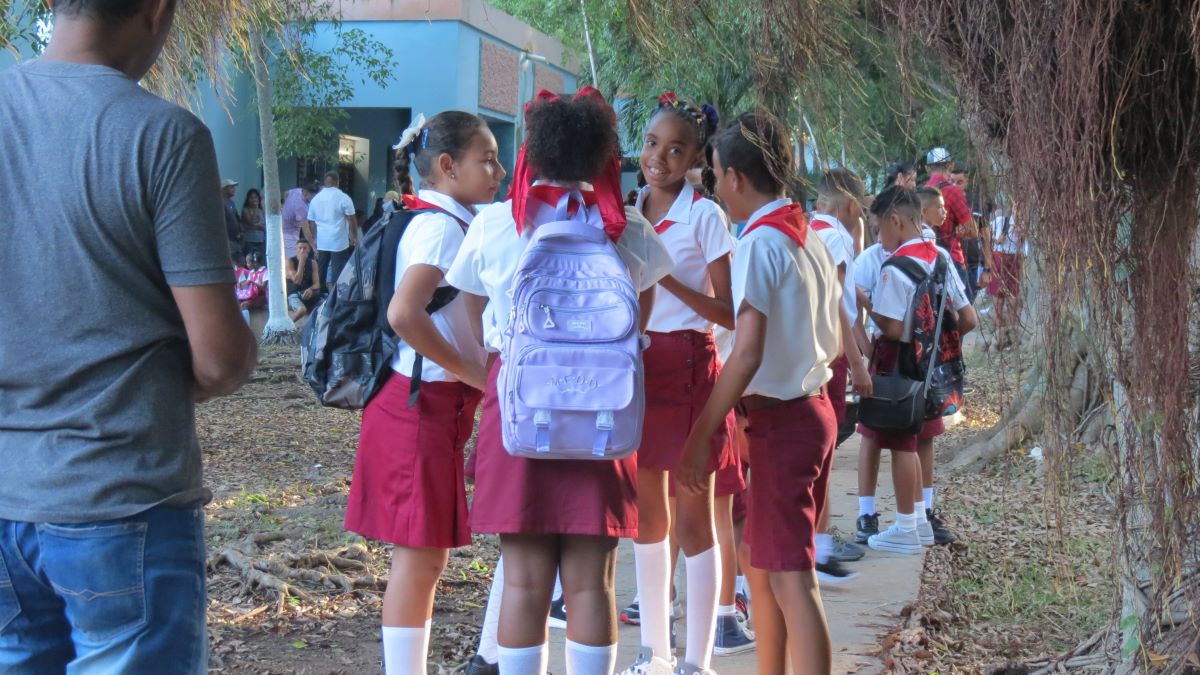With the Euro trading at 330 pesos, a box of school materials sent from Spain to Caridad in Havana would have cost her 19,800 pesos. This Havana woman did not have to pay that outrageous sum for her fourth-grade son’s materials, impossible to cover on her state salary of 5,300 pesos. Her brother, who lives in Madrid, surprised her with the gift.
"I managed to get almost all the material, which was a relief. The package contained a backpack, a set of rulers, a pen-and-pencil case with 23 items, markers, highlighters, two notebooks, a mechanical pencil, eraser, glue stick, a compass, and a Champions League folder, all with Real Madrid and Champions League designs for the kid," she told DIARIO DE CUBA.
Most Cuban families, however, are not so fortunate. The school year began in Cuba on September 2, and, though the Government boasts of free education in its propaganda, it has not been so for some time. In recent years, in addition, inflation has made it harder and harder for workers to afford school supplies. Unable to provide material resources, including uniforms, and suffering from a lack of teachers, the Government has saddled families with ever-heavier burdens.
Marta told DIARIO DE CUBA that she went directly to a Santa Clara store to buy some notebooks. "I bought some for 200 pesos. Then they had some smaller ones for 100, so I bought more."
In the capital of Villa Clara, another mother bemoaned the expenses that the back-to-school period entails. "You go to La Candonga and there's everything, but the prices are through the roof. Yesterday a friend brought me some pencils and some pens. I have some notebooks left over from last year, and I'll start using each one for two subjects, not to mention that I have to find him a tutor because he's already in fifth grade and is doing very badly. He didn't even have a teacher almost half of last year, so how are they supposed to learn?"
According to official data, around 1,600,000 general education students returned to the classrooms at 10,000 educational institutions across Cuba on Monday, to start a new school year, with 24,000 teacher positions (one in eight) not covered, and 12,000 people, including retirees, having had to return to the profession.
In recent days the authorities also offered explanations for the "tensions" with uniforms, affected by "organizational and planning deficiencies of the agencies responsible" and also the purchase of fabrics abroad. There is a need for 4.2 million uniforms, with priority having been assigned to 1.7 million for the initial years of each educational stage.
"This isn't easy, each notebook costs 150 pesos. My whole salary goes for just the child's notebooks. Not to mention that the shoes were 5,000 pesos. The uniform isn't his size, and I had to buy it elsewhere. His backpack is the same one from last year, and I hope it lasts half a year, because I can't afford another one. I haven't found white socks. You go to Revolico and you need three months’ salary to pay for everything they need," Xiomara complained.
"Add to that the afternoon snack, and there are days that I don't even have money for him to have breakfast. What are these kids going to learn when things are like this, when everything is so exhausting? I'm tired," she added.
While his uncle sent him a school set via Cuballama (60 dollars, 19,200 pesos), Yoan was eager for a new backpack. In Facebook groups like that of Revolico Cienfuegos, a school backpack was listed at 3,000 pesos on Tuesday. "I feel really bad for the boy, as some of his classmates arrived with backpacks like the ones he wants. I can't afford that. I don't have it. Explaining that to him is difficult and painful," says Sonia, who has an older daughter with other more pressing needs.
"There's nothing here for free," says Adela, who has spent 15,000 pesos thus far, while another mother asked about the start of the year told us: "I've done everything I can to find things, but I can't buy all the notebooks. It's too much, and I'm alone. His father does nothing. I feel really bad, but you he'll have to start out with loose sheets, and I'll buy the notebooks that are missing little by little, when I can. Right now I can't."
Activist Marthadela Tamayo says her 11th-grader was only given six notebooks and a pencil. "They didn't have any books available yet."
With reference to books, Melba Gisell Torres Valle posted on Facebook about the appalling state of her primary school son's textbook. "Get a load of this. This is the book, The World We Live In, that was given to my second grader. We can talk about how tattered it is later, but look at how it jumps from page 6 to 59. Not even Sotomayor jumped like that."
The Government promised new textbooks for this year, and also disclosed that it would be prioritizing the learning of History and a "decolonization program," its new euphemism for indoctrination.
Education Minister Naima Trujillo said that the new textbooks, tools of the Third Upgrading of the National Education System, printed outside Cuba, in a certain scorned country, "have been arriving," but until October they won't be in every classroom.
"I guess those books will run out. They're not issuing any more, and they'll be passed down from student to student, year after year. They're in such bad shape you can't even flip through them anymore. As for their contents...what more can be said? We'll see what new additions and deletions the architects of what enters our children's heads come up with," Patricia said.
